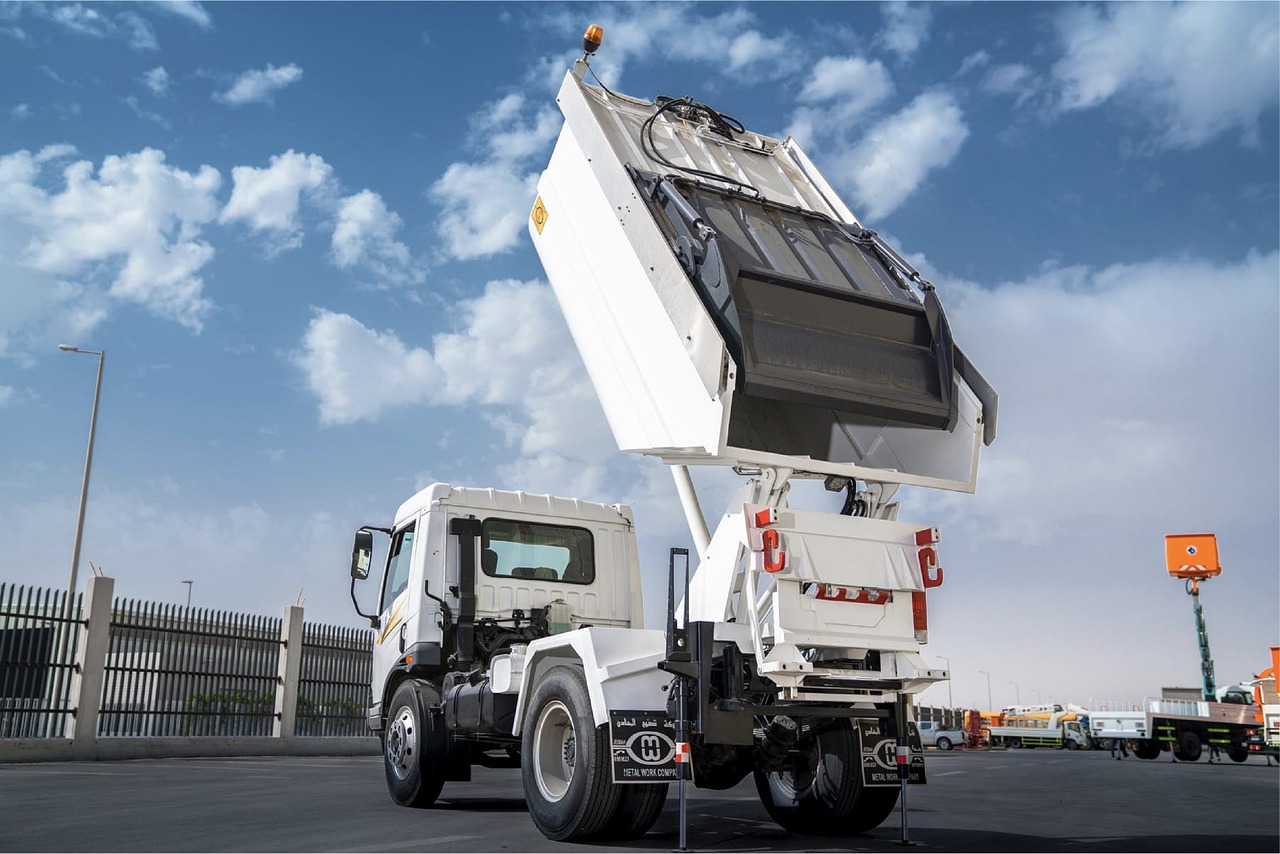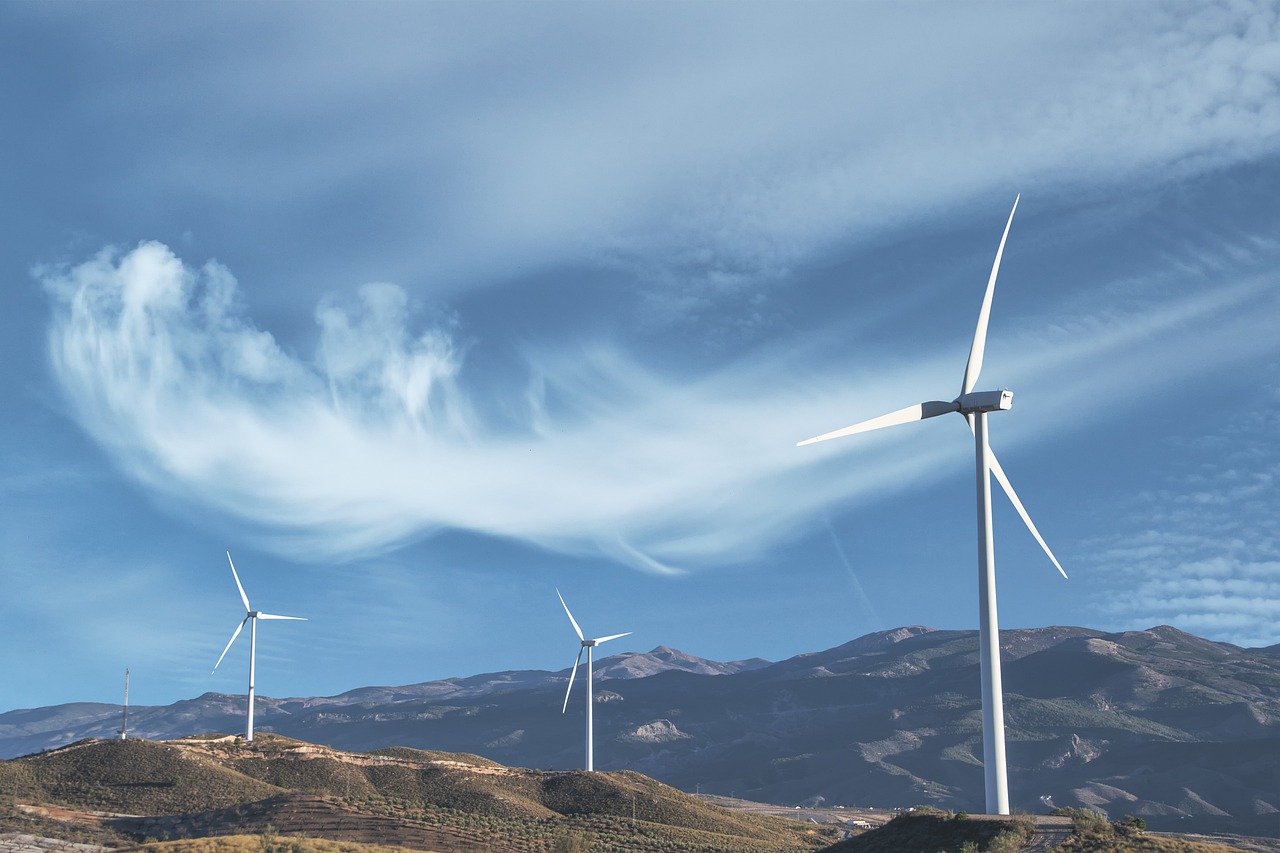Waste-to-Energy: A Sustainable Solution for Urban Areas
In an era where urbanization is skyrocketing, cities are grappling with the growing challenge of waste management. With landfills overflowing and pollution levels rising, the search for innovative solutions has never been more pressing. Enter waste-to-energy (WtE), a revolutionary approach that not only addresses waste disposal but also transforms it into a valuable energy resource. Imagine turning what you throw away into something that powers your home or heats your water! This article explores the concept of waste-to-energy, its benefits, technologies involved, and its potential to transform urban waste management into a sustainable energy source.
Waste-to-energy (WtE) is a process that converts non-recyclable waste materials into usable forms of energy, such as electricity, heat, or fuel. This innovative technology hinges on the principle that waste, often seen as a burden, can be repurposed into a resource. The process typically involves the combustion of waste, which generates heat that is then used to produce steam, driving turbines for electricity generation. Alternatively, anaerobic digestion breaks down organic materials, releasing biogas that can be used for heating or electricity. This dual benefit of waste management and energy production makes WtE an attractive option for urban areas looking to tackle their waste challenges while embracing sustainability.
The adoption of waste-to-energy technologies presents numerous advantages, including reduced landfill use, lower greenhouse gas emissions, and the generation of renewable energy. By converting waste into energy, cities can not only manage their waste more effectively but also contribute to a cleaner environment. Below are some of the key benefits:
Waste-to-energy significantly mitigates environmental issues linked to waste disposal. Traditional methods of waste management, like landfilling, contribute to soil and water pollution, while incineration without energy recovery leads to harmful emissions. In contrast, WtE processes are designed to minimize these negative impacts. By reducing the volume of waste that ends up in landfills, WtE helps preserve natural landscapes and reduces the need for new landfill sites, which can be both costly and environmentally damaging.
By transforming waste into energy, cities can decrease their reliance on landfills. This section highlights the importance of reducing landfill usage for sustainable urban development. Landfills are not just unsightly; they produce methane, a potent greenhouse gas that contributes to climate change. WtE facilities can divert a significant portion of waste from landfills, thus playing a crucial role in urban sustainability.
Waste-to-energy plants can help lower greenhouse gas emissions compared to traditional waste disposal methods. This part examines the role of WtE in combating climate change. By capturing and utilizing the energy from waste, WtE facilities reduce the amount of methane released into the atmosphere, making them a vital component in global efforts to combat climate change.
Various technologies are employed in waste-to-energy systems, including incineration, anaerobic digestion, and gasification. Each method offers unique advantages and operational mechanisms:
| Technology | Description | Energy Output |
|---|---|---|
| Incineration | Burns waste to generate heat, which produces steam for electricity. | Electricity and heat |
| Anaerobic Digestion | Breaks down organic waste in the absence of oxygen, producing biogas. | Biogas for heating and electricity |
| Gasification | Converts organic or fossil-based materials into carbon monoxide, hydrogen, and carbon dioxide. | Synthetic gas (syngas) for energy |
Understanding these technologies is crucial for cities looking to implement waste-to-energy solutions effectively. Each method has its own set of benefits and challenges, making it essential for urban planners to choose the right approach based on their specific waste profiles and energy needs.
The economic feasibility of waste-to-energy projects is crucial for urban planning. The initial investment in WtE technology can be significant, but the long-term savings and revenue generation potential are compelling. By turning waste into energy, cities can reduce their waste management costs and even generate income through energy sales. This subheading discusses the financial implications, including costs, funding, and potential returns on investment.
Conducting a cost-benefit analysis is essential for assessing the viability of waste-to-energy projects. This section explores the financial metrics used to evaluate WtE investments. Factors such as operational costs, maintenance, and the price of energy produced must be weighed against the environmental benefits and potential savings in landfill fees.
Identifying funding sources and investment opportunities is vital for successful WtE implementation. Potential investors include government agencies, private companies, and environmental organizations interested in sustainable solutions. This part discusses potential investors and funding mechanisms available for urban projects, which can help alleviate the financial burden on municipalities.
Despite its benefits, waste-to-energy faces challenges such as public perception, regulatory hurdles, and technological limitations. This section identifies these challenges and explores possible solutions for overcoming them. Public concerns about emissions and safety can be addressed through transparency and education about the technologies used. Additionally, collaboration with regulatory bodies can streamline the permitting process and foster innovation in WtE technologies.
- What is waste-to-energy? Waste-to-energy is a process that converts non-recyclable waste into usable forms of energy, such as electricity and heat.
- How does waste-to-energy benefit the environment? WtE reduces landfill dependency, lowers greenhouse gas emissions, and minimizes pollution associated with waste disposal.
- What technologies are used in waste-to-energy? Common technologies include incineration, anaerobic digestion, and gasification.
- What are the economic implications of waste-to-energy? While initial costs can be high, WtE can lead to long-term savings and revenue generation through energy sales.
- What challenges does waste-to-energy face? Challenges include public perception, regulatory hurdles, and the need for technological advancements.

Understanding Waste-to-Energy
This article explores the concept of waste-to-energy, its benefits, technologies involved, and its potential to transform urban waste management into a sustainable energy source.
Waste-to-energy (WtE) is an innovative process that takes non-recyclable waste materials and transforms them into usable forms of energy, such as electricity, heat, or fuel. Imagine being able to turn yesterday's trash into today’s power source; that’s the magic of WtE! This technology is not just about waste management; it’s about harnessing the potential energy locked within our discarded materials. The fundamental principle is straightforward: through various processes, waste is converted into energy, significantly reducing the volume of waste that ends up in landfills.
At its core, WtE operates on the principle of energy recovery. When waste is incinerated, it generates heat, which can be used to produce steam that drives turbines to generate electricity. Alternatively, some processes utilize anaerobic digestion, where microorganisms break down organic matter in the absence of oxygen, producing biogas that can be used as a renewable energy source. This not only helps in managing waste but also contributes to a more sustainable energy landscape.
Let’s break down the key processes involved in WtE:
- Incineration: This is the most common method, where waste is burned at high temperatures to produce energy.
- Anaerobic Digestion: Organic waste is decomposed by bacteria, producing biogas that can be converted into electricity or heat.
- Gasification: This process converts organic or fossil-based materials into carbon monoxide, hydrogen, and carbon dioxide at high temperatures in an oxygen-starved environment.
Each of these technologies has its unique advantages and challenges, but they all share a common goal: reducing waste and generating energy. The beauty of WtE lies in its ability to address two pressing issues at once: the growing problem of waste disposal and the urgent need for renewable energy. It’s like finding a silver lining in a cloud of trash!
Moreover, WtE is not just an environmental solution; it also plays a pivotal role in the circular economy. By converting waste into energy, we are taking a step towards minimizing resource extraction and promoting sustainability. The materials that cannot be recycled can still serve a purpose, thus reducing the overall demand for new resources. In urban areas, where space is limited and waste generation is high, WtE can be a game changer.
In summary, waste-to-energy is a multifaceted approach that not only helps in managing waste but also provides a sustainable energy source. It’s a win-win situation for cities looking to enhance their waste management strategies while also contributing to a greener future.
The adoption of waste-to-energy technologies presents numerous advantages, including reduced landfill use, lower greenhouse gas emissions, and the generation of renewable energy. Here, we explore these benefits in detail.
Waste-to-energy significantly mitigates environmental issues linked to waste disposal. This subheading discusses how WtE reduces pollution and contributes to a cleaner urban environment.
By transforming waste into energy, cities can decrease their reliance on landfills. This section highlights the importance of reducing landfill usage for sustainable urban development.
Waste-to-energy plants can help lower greenhouse gas emissions compared to traditional waste disposal methods. This part examines the role of WtE in combating climate change.
Various technologies are employed in waste-to-energy systems, including incineration, anaerobic digestion, and gasification. This section outlines these technologies and their operational mechanisms.
The economic feasibility of waste-to-energy projects is crucial for urban planning. This subheading discusses the financial implications, including costs, funding, and potential returns on investment.
Conducting a cost-benefit analysis is essential for assessing the viability of waste-to-energy projects. This section explores the financial metrics used to evaluate WtE investments.
Identifying funding sources and investment opportunities is vital for successful WtE implementation. This part discusses potential investors and funding mechanisms available for urban projects.
Despite its benefits, waste-to-energy faces challenges such as public perception, regulatory hurdles, and technological limitations. This section identifies these challenges and explores possible solutions for overcoming them.
Here are some common questions about waste-to-energy:
- What types of waste can be used for WtE? Generally, non-recyclable waste, including municipal solid waste, industrial waste, and agricultural residues can be utilized.
- Is WtE safe for the environment? Yes, when managed properly, WtE can significantly reduce harmful emissions and contribute to cleaner air and water.
- How does WtE compare to traditional landfilling? WtE reduces the volume of waste and generates energy, while landfilling merely stores waste without recovering any resources.

Benefits of Waste-to-Energy
When we think about waste, we often picture overflowing landfills and the unpleasant odors that accompany them. But what if I told you that we could turn that waste into a valuable resource? Waste-to-energy (WtE) technologies offer a transformative solution that not only reduces the amount of waste sent to landfills but also generates energy. The benefits of WtE are numerous and can significantly impact urban areas, making them cleaner and more sustainable.
One of the most compelling advantages of waste-to-energy is its ability to reduce landfill dependency. In many cities, landfills are reaching their capacity, leading to a pressing need for alternative waste management solutions. By converting waste into energy, cities can minimize the amount of waste that ends up in landfills. This not only prolongs the lifespan of existing landfills but also reduces the environmental hazards associated with landfill sites, such as soil and water contamination.
Moreover, waste-to-energy facilities contribute to a significant reduction in greenhouse gas emissions. Traditional waste disposal methods, such as landfilling, produce methane, a potent greenhouse gas that is far more harmful than carbon dioxide. In contrast, WtE plants utilize advanced technologies that capture and convert waste into energy while minimizing emissions. This process not only helps combat climate change but also promotes cleaner air quality in urban environments.
Additionally, WtE facilities can generate renewable energy that can be used to power homes and businesses. This energy can take various forms, including electricity, heat, or even biofuels, providing cities with a reliable and sustainable energy source. By harnessing the energy stored in waste, we can reduce our reliance on fossil fuels and contribute to a more sustainable energy future.
Another important aspect of waste-to-energy is its potential to create economic opportunities. Establishing WtE facilities can lead to job creation in various sectors, including construction, operation, and maintenance. These jobs not only support the local economy but also help foster a sense of community involvement in sustainability efforts. Furthermore, the energy produced can reduce energy costs for municipalities, leading to savings that can be redirected towards other important urban development projects.
In summary, the benefits of waste-to-energy extend beyond merely managing waste. They encompass environmental, economic, and social advantages that contribute to a more sustainable urban landscape. By investing in WtE technologies, cities can pave the way for a cleaner, greener future while tackling the pressing issues of waste management and energy production.
- What is waste-to-energy? Waste-to-energy is a process that converts non-recyclable waste materials into usable forms of energy, such as electricity, heat, or fuel.
- How does waste-to-energy reduce landfill use? By converting waste into energy, it decreases the volume of waste that needs to be disposed of in landfills.
- Can waste-to-energy help combat climate change? Yes, WtE facilities can significantly lower greenhouse gas emissions compared to traditional waste disposal methods, thus helping to mitigate climate change.
- What kinds of energy can be produced from waste? Waste can be converted into electricity, heat, or biofuels, providing various energy options for urban areas.
- Are there economic benefits to waste-to-energy? Yes, WtE projects can create jobs, reduce energy costs, and provide funding for other urban development initiatives.

Environmental Impact
The environmental impact of waste-to-energy (WtE) technologies is profound and multifaceted. By converting waste into usable energy, WtE systems play a crucial role in mitigating the negative effects of waste disposal on our planet. One of the most significant benefits is the reduction of pollution associated with traditional waste management methods. Landfills are notorious for emitting harmful gases, including methane, a potent greenhouse gas. In contrast, WtE facilities are designed to capture and utilize these emissions, transforming what would be a harmful byproduct into a valuable energy source. This not only helps in reducing the overall carbon footprint but also contributes to cleaner air quality in urban areas.
Moreover, WtE plants significantly decrease the volume of waste that ends up in landfills. In fact, studies show that WtE can reduce waste mass by up to 90%. This reduction is not just a numbers game; it translates into fewer landfills, which means less land use and lower risks of soil and groundwater contamination. The environmental benefits are clear: by diverting waste from landfills, we are actively contributing to a more sustainable urban ecosystem.
It's also essential to consider the lifecycle of waste management. Traditional methods often involve a linear approach—collect, dump, and forget. On the other hand, WtE promotes a circular economy where waste is seen not as a problem but as a resource. This shift in perspective is vital for fostering a culture of sustainability. When we treat waste as a resource, we open up opportunities for innovation and responsible energy production.
Additionally, WtE technologies contribute to reducing greenhouse gas emissions. By generating energy from waste, these systems produce significantly lower emissions compared to fossil fuels. For instance, a typical WtE plant emits about 50% less CO2 than a coal-fired power plant. This is a game-changer in our fight against climate change. The table below illustrates a comparison of emissions from different waste disposal methods:
| Method | CO2 Emissions (per ton of waste) |
|---|---|
| Landfill | 1000 kg |
| Incineration (WtE) | 500 kg |
| Coal-fired Power Plant | 2000 kg |
As we look towards the future, it’s clear that embracing waste-to-energy technologies is not just a choice but a necessity for sustainable urban living. The environmental impact of WtE is overwhelmingly positive, providing a pathway to cleaner air, reduced landfill reliance, and a significant contribution to combating climate change. In a world where urban areas are increasingly burdened by waste, WtE stands out as a beacon of hope, showcasing how we can turn trash into treasure.
To wrap it up, the environmental benefits of waste-to-energy systems are vast and varied. They not only address waste management challenges but also play a pivotal role in creating a more sustainable future for our cities and the planet as a whole.
- What is waste-to-energy? Waste-to-energy is a process that converts non-recyclable waste materials into usable forms of energy, such as electricity, heat, or fuel.
- How does waste-to-energy reduce pollution? WtE significantly reduces the amount of waste sent to landfills, which in turn lowers greenhouse gas emissions and other pollutants associated with waste disposal.
- Can waste-to-energy help combat climate change? Yes, by generating energy from waste and reducing reliance on fossil fuels, WtE can help lower overall greenhouse gas emissions.
- What technologies are used in waste-to-energy? Common technologies include incineration, anaerobic digestion, and gasification.

Reducing Landfill Dependency
In today's world, where urban areas are expanding rapidly, the issue of waste management has become increasingly pressing. Landfills, once considered a viable solution for waste disposal, are now viewed as a significant environmental concern. The concept of waste-to-energy (WtE) presents a powerful alternative that not only addresses waste disposal but also transforms it into a valuable resource. By converting waste into energy, cities can significantly reduce their dependency on landfills, paving the way for a more sustainable future.
One of the most compelling reasons for reducing landfill dependency through WtE is the sheer volume of waste generated in urban areas. According to recent studies, the average person generates about 4.5 pounds of waste daily. When multiplied by millions of residents, the numbers become staggering. This waste typically ends up in landfills, which can lead to soil and groundwater contamination, not to mention the greenhouse gases emitted during decomposition. By adopting WtE technologies, cities can divert a significant portion of this waste from landfills, effectively turning what was once considered refuse into a source of energy.
Moreover, reducing landfill dependency has a cascading effect on urban development. As cities embrace WtE, they can reclaim valuable land that would otherwise be consumed by landfills. This reclaimed land can be repurposed for parks, housing, or commercial developments, contributing to a more vibrant urban ecosystem. Imagine a city where green spaces flourish in areas once dominated by waste; it’s not just a dream but a tangible outcome of effective waste management strategies.
To illustrate the potential impact, consider the following table that outlines the benefits of reducing landfill dependency through WtE:
| Benefit | Description |
|---|---|
| Landfill Space Conservation | By diverting waste to WtE facilities, cities can conserve valuable land that would otherwise be used for landfills. |
| Environmental Protection | Reducing landfill waste decreases pollution and mitigates harmful emissions, contributing to cleaner air and water. |
| Energy Generation | Transforming waste into energy provides a renewable source of power, reducing reliance on fossil fuels. |
| Economic Development | Reclaimed land and reduced waste costs can lead to new business opportunities and job creation. |
The transition to WtE is not just about reducing landfill dependency; it’s about fostering a culture of sustainability. When communities understand the benefits of diverting waste from landfills, they are more likely to embrace recycling and composting initiatives. This holistic approach to waste management empowers citizens to take an active role in their environment, leading to a cleaner, greener city.
In conclusion, the need to reduce landfill dependency through waste-to-energy technologies is critical for urban areas facing waste management challenges. By transforming waste into energy, cities can reclaim land, protect the environment, and create new economic opportunities. It’s a win-win situation that not only benefits the present but also secures a sustainable future for generations to come.
- What is waste-to-energy? Waste-to-energy is a process that converts non-recyclable waste materials into usable forms of energy, such as electricity, heat, or fuel.
- How does waste-to-energy help reduce landfill use? By converting waste into energy, WtE technologies divert waste from landfills, thereby decreasing the volume of waste that needs to be disposed of in landfills.
- What are the environmental benefits of waste-to-energy? WtE reduces pollution, lowers greenhouse gas emissions, and conserves natural resources by generating renewable energy from waste.
- Are there any challenges associated with waste-to-energy? Yes, challenges include public perception, regulatory hurdles, and technological limitations, which need to be addressed for successful implementation.

Lowering Greenhouse Gas Emissions
The fight against climate change is one of the most pressing issues of our time, and waste-to-energy (WtE) technology plays a pivotal role in this battle. By converting waste materials into energy, WtE significantly reduces the amount of waste sent to landfills, which in turn lowers greenhouse gas emissions (GHGs) that would otherwise be released during the decomposition of organic waste. When waste decomposes in a landfill, it produces methane, a potent greenhouse gas that is over 25 times more effective at trapping heat in the atmosphere than carbon dioxide over a 100-year period.
In contrast, waste-to-energy facilities utilize advanced combustion technologies that convert waste into energy while minimizing emissions. These plants are designed to capture and control pollutants, ensuring that harmful gases are filtered out before they can enter the atmosphere. The result? A cleaner, greener urban environment. For instance, studies have shown that WtE can reduce GHG emissions by up to 80% compared to traditional landfill disposal methods.
Moreover, the energy produced from WtE can replace fossil fuels, further decreasing carbon footprints. When cities harness energy from waste, they can reduce their reliance on coal, oil, and natural gas, which are major contributors to greenhouse gas emissions. This transition not only supports a more sustainable energy model but also promotes energy security and independence.
To illustrate the impact of waste-to-energy on greenhouse gas emissions, consider the following table that compares the emissions from various waste management methods:
| Waste Management Method | Greenhouse Gas Emissions (CO2 Equivalent) |
|---|---|
| Landfill | 1000 kg |
| Waste-to-Energy | 200 kg |
| Recycling | 50 kg |
As we can see, waste-to-energy significantly lowers emissions compared to landfilling waste. This not only contributes to cleaner air but also helps cities meet their climate goals. The integration of WtE into urban waste management systems is a vital step towards achieving sustainability and combating climate change.
In conclusion, the role of waste-to-energy in lowering greenhouse gas emissions cannot be overstated. By transforming waste into a valuable energy resource, cities can significantly reduce their carbon footprints while promoting a circular economy. As urban areas continue to grow, embracing waste-to-energy technologies will be crucial for creating a sustainable future.
- What is waste-to-energy? Waste-to-energy is a process that converts non-recyclable waste materials into usable forms of energy, such as electricity, heat, or fuel.
- How does waste-to-energy reduce greenhouse gas emissions? By diverting waste from landfills and converting it into energy, WtE minimizes methane emissions from decomposing waste and reduces reliance on fossil fuels.
- What technologies are used in waste-to-energy? Common technologies include incineration, anaerobic digestion, and gasification, each with its own operational mechanisms.
- Are there any challenges associated with waste-to-energy? Yes, challenges include public perception, regulatory hurdles, and technological limitations, but solutions are being developed to address these issues.

Technologies Used in Waste-to-Energy
When we talk about waste-to-energy (WtE), it's essential to understand the various technologies that make this transformation possible. These technologies are the backbone of the WtE process, turning everyday waste into valuable energy resources. Each method has its unique approach and benefits, catering to different types of waste and energy needs. Let's dive into three primary technologies that are revolutionizing the way we manage waste and generate energy.
First up is incineration. This method involves burning waste at high temperatures, which not only reduces the volume of waste significantly but also generates heat energy. The heat produced can be used to create steam, which drives turbines to generate electricity. While incineration is effective, it does raise concerns regarding emissions. However, modern incineration plants are equipped with advanced filtration systems that minimize harmful emissions, making them far more environmentally friendly than older models.
Next, we have anaerobic digestion. This process uses microorganisms to break down organic waste in the absence of oxygen. The result? Biogas, which is primarily composed of methane, can be captured and used for heating or electricity generation. Anaerobic digestion not only reduces the amount of waste that ends up in landfills but also produces a nutrient-rich digestate that can be used as fertilizer. It's like turning your kitchen scraps into energy and plant food!
Another innovative technology is gasification. This method converts organic or fossil-based materials into carbon monoxide, hydrogen, and carbon dioxide through a high-temperature process that occurs with limited oxygen. The resulting syngas can be used to generate electricity or be converted into liquid fuels. Gasification is particularly appealing because it can handle a wide variety of waste materials, including plastics and agricultural waste, making it a versatile option in the WtE landscape.
| Technology | Process | Energy Output | Environmental Impact |
|---|---|---|---|
| Incineration | Burning waste at high temperatures | Electricity and heat | Reduces landfill waste but may emit pollutants |
| Anaerobic Digestion | Breaking down organic waste without oxygen | Biogas (methane) | Reduces waste and produces fertilizer |
| Gasification | Converting materials into syngas using high temperatures | Electricity or liquid fuels | Handles diverse waste types, minimal emissions |
In summary, the technologies used in waste-to-energy systems are not just about energy production; they represent a shift toward sustainable waste management. By employing methods like incineration, anaerobic digestion, and gasification, urban areas can significantly reduce their waste footprint while generating clean energy. The beauty of these technologies lies in their ability to adapt to various waste types and energy needs, making them integral to a sustainable future.
- What types of waste can be processed using waste-to-energy technologies?
Most waste-to-energy technologies can handle a variety of non-recyclable waste, including municipal solid waste, agricultural waste, and industrial by-products.
- Are waste-to-energy plants safe for the environment?
Modern waste-to-energy plants are designed with advanced emission control technologies that significantly reduce harmful emissions, making them much safer than older facilities.
- How does waste-to-energy contribute to renewable energy goals?
By converting waste into energy, these systems provide a renewable source of energy, helping to reduce reliance on fossil fuels and lower greenhouse gas emissions.

Economic Considerations
The economic feasibility of waste-to-energy (WtE) projects plays a pivotal role in urban planning and management. As cities grapple with increasing waste generation and the pressing need for sustainable energy solutions, understanding the financial implications of WtE becomes crucial. These projects not only promise environmental benefits but also have the potential to deliver significant economic returns. However, assessing the viability of these initiatives requires a thorough analysis of costs, funding sources, and potential returns on investment.
When evaluating the financial aspects of WtE, it's essential to conduct a comprehensive cost-benefit analysis. This analysis should include both direct and indirect costs associated with the project. Direct costs encompass construction, operation, and maintenance expenses of WtE facilities, while indirect costs might involve environmental impacts, health considerations, and social implications. By comparing these costs against the expected benefits—such as energy production, reduced landfill fees, and potential revenue from energy sales—stakeholders can make informed decisions about proceeding with WtE initiatives.
| Cost Component | Description |
|---|---|
| Construction Costs | Expenses related to building WtE facilities, including labor, materials, and permits. |
| Operational Costs | Recurring costs for running the facility, including staffing, maintenance, and utilities. |
| Revenue Potential | Income generated from electricity sales, heat production, and possibly carbon credits. |
Additionally, identifying funding and investment opportunities is vital for the successful implementation of WtE projects. Various sources of funding can be tapped into, including government grants, private investments, and public-private partnerships. These collaborations can significantly alleviate the financial burden on municipalities and encourage sustainable urban development. For instance, international organizations and environmental NGOs often provide financial support for projects that align with their sustainability goals.
Moreover, the potential for returns on investment in WtE projects is substantial. By converting waste into energy, cities can not only save on waste management costs but also generate revenue through energy production. The long-term savings from reduced landfill usage and lower greenhouse gas emissions further enhance the economic appeal of WtE. Cities that embrace this technology can position themselves as leaders in sustainability while reaping the economic benefits that come with it.
In conclusion, the economic considerations surrounding waste-to-energy projects are multifaceted and require careful analysis. By understanding the costs, exploring funding opportunities, and recognizing the potential for significant returns, urban planners and decision-makers can make informed choices that promote both environmental sustainability and economic growth.
- What is waste-to-energy? Waste-to-energy is a process that converts non-recyclable waste materials into usable forms of energy, such as electricity or heat.
- How does waste-to-energy benefit the environment? It reduces landfill dependency, lowers greenhouse gas emissions, and mitigates pollution from waste disposal.
- What are the main technologies used in waste-to-energy? The main technologies include incineration, anaerobic digestion, and gasification.
- Is waste-to-energy economically viable? Yes, with proper cost-benefit analysis and funding sources, waste-to-energy projects can be economically beneficial.
- How can cities fund waste-to-energy projects? Cities can seek government grants, private investments, and engage in public-private partnerships to fund these initiatives.

Cost-Benefit Analysis
Conducting a is essential for assessing the viability of waste-to-energy (WtE) projects. This analysis not only evaluates the initial investment required but also considers the long-term benefits that these projects can bring to urban areas. By understanding both the costs and the benefits, city planners and stakeholders can make informed decisions that align with sustainability goals.
When analyzing the costs associated with WtE projects, several factors come into play. These include capital expenditures for building and maintaining the energy conversion facilities, operational costs, and the potential costs associated with regulatory compliance. However, the benefits can often outweigh these costs significantly. For instance, WtE facilities can generate substantial amounts of renewable energy, which can reduce reliance on fossil fuels and lower energy costs for municipalities.
Additionally, WtE projects contribute to reduced waste management expenses. By diverting waste from landfills, cities can save on landfill fees and reduce the environmental impact associated with waste disposal. This is particularly important as landfills are becoming increasingly costly to maintain and operate. A well-structured cost-benefit analysis will take these savings into account, presenting a clearer picture of the financial implications of WtE.
To illustrate the potential financial benefits of WtE, consider the following table that outlines some key metrics:
| Cost/Benefit | Estimated Value |
|---|---|
| Initial Capital Investment | $10 million |
| Annual Operational Cost Savings | $2 million |
| Annual Revenue from Energy Sales | $3 million |
| Reduction in Landfill Fees | $1.5 million |
| Net Benefit After 10 Years | $15 million |
As shown in the table, the initial capital investment may seem daunting, but the long-term savings and revenue generation can lead to a significant net benefit over time. This is where the real power of a cost-benefit analysis shines—by providing a comprehensive view of both short-term and long-term financial impacts.
Moreover, it’s essential to consider the social benefits of WtE projects, which can be harder to quantify but are equally important. These include job creation in the energy sector, improved public health through reduced pollution, and enhanced community engagement in sustainability initiatives. A thorough cost-benefit analysis should encompass these social aspects, providing a holistic view of the project's impact.
In conclusion, a well-conducted cost-benefit analysis is crucial for the successful implementation of waste-to-energy projects. It not only helps in understanding the financial implications but also aids in garnering support from stakeholders and the public. By highlighting both the economic and social benefits, cities can pave the way for a more sustainable future through effective waste management solutions.
- What is waste-to-energy? Waste-to-energy is a process that converts non-recyclable waste materials into usable forms of energy, such as electricity, heat, or fuel.
- How does waste-to-energy benefit the environment? It reduces landfill use, lowers greenhouse gas emissions, and generates renewable energy, contributing to a cleaner urban environment.
- What are the main technologies used in waste-to-energy? The primary technologies include incineration, anaerobic digestion, and gasification.
- Is waste-to-energy economically viable? Yes, when properly analyzed, the long-term benefits often outweigh the initial costs, leading to significant net benefits over time.

Funding and Investment Opportunities
In the realm of waste-to-energy (WtE) projects, securing adequate funding and identifying viable investment opportunities are pivotal for their successful implementation. The financial landscape for WtE is as dynamic as the technology itself, often requiring a multifaceted approach to attract the necessary capital. Various funding sources are available, ranging from public sector investments to private sector partnerships. This blend can provide a robust financial framework that supports the development of sustainable energy solutions.
Public funding plays a crucial role in initiating WtE projects. Many governments offer grants, subsidies, and low-interest loans to encourage the adoption of renewable energy technologies. These financial incentives can significantly reduce the initial capital burden on municipalities and private entities venturing into waste-to-energy systems. For instance, the European Union has established various funding programs aimed at promoting green energy initiatives, including WtE projects. Similarly, local and state governments often have specific budgets allocated for environmental sustainability projects, which can encompass WtE.
On the other hand, private investment is equally important. Venture capitalists and private equity firms are increasingly recognizing the potential of WtE as a sustainable investment opportunity. The growing emphasis on environmental, social, and governance (ESG) criteria has led many investors to seek out projects that contribute positively to the environment. Furthermore, the potential for long-term returns on investment in WtE projects, coupled with the increasing demand for renewable energy, makes this sector attractive to investors.
To better understand the funding landscape, consider the following table that outlines the primary sources of funding for waste-to-energy projects:
| Funding Source | Description | Example |
|---|---|---|
| Government Grants | Financial support from governmental bodies to promote renewable energy projects. | U.S. Department of Energy Grants |
| Public-Private Partnerships | Collaboration between government entities and private companies to fund WtE projects. | City and private firm partnerships for facility development |
| Venture Capital | Investment from private equity firms focused on innovative and sustainable technologies. | Green investment funds |
| International Funding | Financial aid from international organizations to support sustainable development. | World Bank environmental initiatives |
Moreover, the financial viability of WtE projects can be further enhanced by exploring innovative financing mechanisms, such as green bonds or climate bonds. These financial instruments are specifically designed to raise funds for projects that have positive environmental impacts. By issuing green bonds, municipalities can attract socially responsible investors who are eager to support sustainable initiatives.
In conclusion, the path to funding and investment in waste-to-energy projects is paved with opportunities. By leveraging public funding, private investments, and innovative financing solutions, urban areas can not only tackle their waste management challenges but also contribute to a greener, more sustainable future. The synergy between environmental responsibility and economic viability makes WtE an attractive proposition for both investors and communities alike.
- What is waste-to-energy? Waste-to-energy is a process that converts non-recyclable waste materials into usable forms of energy, such as electricity, heat, or fuel.
- How does waste-to-energy benefit the environment? WtE reduces landfill dependency, lowers greenhouse gas emissions, and contributes to cleaner urban environments.
- What are the main funding sources for WtE projects? Funding sources include government grants, public-private partnerships, venture capital, and international funding.
- Can individuals invest in waste-to-energy projects? Yes, individuals can invest indirectly through green bonds or by supporting companies and funds that focus on renewable energy projects.

Challenges and Solutions
Despite the numerous advantages of waste-to-energy (WtE) systems, there are significant challenges that must be addressed for successful implementation. One of the primary hurdles is public perception. Many communities harbor skepticism regarding the safety and environmental impact of waste-to-energy facilities, often viewing them as potential pollution sources rather than as sustainable solutions. This perception can stem from a lack of understanding about the technologies used and the strict regulations governing these plants. To tackle this issue, it is crucial to engage with the community through educational programs and transparent communication. By providing clear information about the benefits and safety measures in place, cities can foster a more favorable public opinion.
Another challenge is the regulatory framework surrounding waste-to-energy projects. Different regions have varying regulations, which can complicate the development and operation of WtE facilities. Navigating these regulations requires a thorough understanding of local laws and often involves lengthy approval processes. To overcome this, collaboration with local governments and regulatory bodies is essential. Establishing a clear line of communication can streamline the approval process and ensure that all parties are aligned on the project’s goals and compliance requirements.
Technological limitations also pose a challenge for waste-to-energy systems. While advancements have been made, some technologies may not be suitable for all types of waste or may require significant investment to implement effectively. For instance, gasification and anaerobic digestion technologies can be highly efficient, but they may not be as widely adopted due to high initial costs or operational complexities. To address this, ongoing research and development are vital. Investing in innovative technologies can lead to more efficient processes and better energy recovery rates, ultimately making WtE a more attractive option for urban waste management.
Lastly, the financial aspects of waste-to-energy projects cannot be overlooked. Initial capital investment can be substantial, and securing funding is often a significant barrier. Many municipalities struggle to find the necessary resources to launch these projects. To combat this, potential funding sources, such as government grants, private investors, and public-private partnerships, should be explored. Additionally, conducting a thorough cost-benefit analysis can help demonstrate the long-term savings and environmental benefits of WtE, making it easier to attract investment.
In summary, while waste-to-energy presents a sustainable solution for urban waste management, it is not without its challenges. Addressing public perception through education, navigating regulatory frameworks, overcoming technological limitations, and securing funding are all critical steps in the process. By tackling these challenges head-on, cities can unlock the full potential of waste-to-energy systems and move toward a more sustainable future.
- What is waste-to-energy? Waste-to-energy is a process that converts non-recyclable waste materials into usable forms of energy, such as electricity, heat, or fuel.
- How does waste-to-energy benefit the environment? It reduces landfill use, lowers greenhouse gas emissions, and generates renewable energy, contributing to a cleaner urban environment.
- What technologies are used in waste-to-energy? Common technologies include incineration, anaerobic digestion, and gasification.
- What are the economic considerations for waste-to-energy projects? Economic feasibility involves assessing costs, funding opportunities, and potential returns on investment.
- What challenges does waste-to-energy face? Challenges include public perception, regulatory hurdles, technological limitations, and financial constraints.
Frequently Asked Questions
- What is waste-to-energy (WtE)?
Waste-to-energy (WtE) is a process that converts non-recyclable waste materials into usable forms of energy, like electricity, heat, or fuel. It’s a clever way to tackle waste disposal while generating energy, making it a win-win for urban areas!
- How does waste-to-energy benefit the environment?
WtE significantly reduces landfill dependency and lowers greenhouse gas emissions. By converting waste into energy, it helps keep our cities cleaner and combats climate change, which is crucial for a sustainable future.
- What technologies are used in waste-to-energy systems?
There are several technologies involved in WtE, including incineration, anaerobic digestion, and gasification. Each technology has its own unique way of converting waste into energy, ensuring we can efficiently manage urban waste.
- Is waste-to-energy economically feasible?
Yes, waste-to-energy projects can be economically viable. Conducting a thorough cost-benefit analysis helps determine the financial implications, funding options, and potential returns on investment, making it a smart option for urban planning.
- What challenges does waste-to-energy face?
Waste-to-energy projects encounter challenges like public perception, regulatory hurdles, and technological limitations. However, with proper communication and innovative solutions, these challenges can be effectively addressed.
- Can waste-to-energy help in reducing greenhouse gas emissions?
Absolutely! Waste-to-energy plants can significantly lower greenhouse gas emissions compared to traditional waste disposal methods. By converting waste into energy, we not only reduce emissions but also contribute to a more sustainable energy future.
- How can cities fund waste-to-energy projects?
Cities can explore various funding sources, including government grants, private investors, and public-private partnerships. Identifying the right funding mechanisms is crucial for the successful implementation of waste-to-energy initiatives.


















